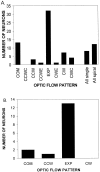Optic flow selectivity in the anterior superior temporal polysensory area, STPa, of the behaving monkey
- PMID: 10087081
- PMCID: PMC6786053
- DOI: 10.1523/JNEUROSCI.19-07-02681.1999
Optic flow selectivity in the anterior superior temporal polysensory area, STPa, of the behaving monkey
Abstract
Earlier studies of neurons in the anterior region of the superior temporal polysensory area (STPa) have demonstrated selectivity for visual motion using stimuli contaminated by nonmotion cues, including texture, luminance, and form. The present experiments investigated the motion selectivity of neurons in STPa in the absence of form cues using random dot optic flow displays. The responses of neurons were tested with translation, rotation, radial, and spiral optic flow displays designed to mimic the types of motion that occur during locomotion. Over half of the neurons tested responded significantly to at least one of these displays. On a cell by cell basis, 60% of the neurons tested responded selectively to rotation, radial, and spiral motion, whereas 20% responded selectively to translation motion. The majority of neurons responded maximally to single-component optic flow displays but was also significantly activated by the spiral displays that contained their preferred component. Moreover, there was a bias in the selectivity of the neurons for radial expansion motion. These results suggest that neurons within STPa are contributing to the analysis of optic flow. Furthermore, the preponderance of cells selective for radial expansion provides evidence that this area may be specifically involved in the processing of forward locomotion and/or looming stimuli. Finally, these results provide carefully controlled physiological evidence for an extension and specialization of the motion-processing pathway into the anterior temporal lobe.
Figures









References
-
- Albright TD. Direction and orientation selectivity of neurons in visual area MT of the macaque. J Neurophysiol. 1984;52:1106–1130. - PubMed
-
- Allman JM, Kaas JH, Lane RH. The middle temporal visual area (MT) in the bushbaby, Galago senegalensis. Brain Res. 1973;57:197–202. - PubMed
-
- Andersen RA, Asanuma C, Essick GK, Siegel RM. Corticocortical connections of anatomically and physiologically defined subdivisions within inferior parietal lobule. J Comp Neurol. 1990;296:65–113. - PubMed
-
- Andersen RA, Snyder LH, Bradley DC, Xing J. Multimodal representation of space in the posterior parietal cortex and its use in planning movements. Annu Rev Neurosci. 1997;20:303–330. - PubMed
-
- Anderson KC, Siegel RM. Psychophysical studies of rotation, radial, and spiral motion in monkey. Soc Neurosci Abstr. 1993;19:774.
Publication types
MeSH terms
Grants and funding
LinkOut - more resources
Full Text Sources
Other Literature Sources
